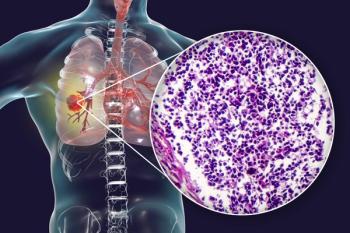
MicroRNA Test Could Improve Lung Cancer Screening Accuracy
The use of a microRNA signature classifier assay was found to have high predictive, diagnostic, and prognostic value in a lung cancer screening trial in Italy. Adding the plasma microRNA test to low-dose CT screening reduced false positive rates.
The use of a microRNA signature classifier (MSC) assay was found to have high predictive, diagnostic, and prognostic value in a lung cancer screening trial in Italy. Adding the plasma microRNA test to low-dose CT screening reduced false positive rates fivefold.
Several trials have shown benefit with low-dose CT screening, most notably the National Lung Screening Trial that found a 20% mortality reduction in high-risk individuals compared with chest radiography. “However, high false positive rates, the cost of screening the large number of individuals at high risk (estimated at 3.5 million in the United States), and the potential harms associated with [low-dose CT] screening highlight the need for complementary biomarkers for standardized diagnostic use,” wrote study authors led by Ugo Pastorino, MD, of the Instituto Nazionale dei Tumori in Milan, Italy.
The investigators retrospectively examined the utility of a noninvasive plasma microRNA marker in 939 participants of a low-dose CT screening trial; these included 69 patients with lung cancer and 870 disease-free individuals. MicroRNAs are non-coding RNAs that “modulate gene activity and are aberrantly expressed in most types of cancer.” The microRNA assay led to classification of participants as low, intermediate, or high risk for lung cancer.
Sixty of the 69 lung cancer patients fell into either the intermediate (29 patients) or high (31 patients) risk groups, and the MSC assay had 87% sensitivity and 81% specificity. Among all patients, the test had a negative predictive value of 99% for detection of cancer and 99.86% for death as a result of disease. A total of 12 patients died due to lung cancer in the high-risk group; 6 patients in the intermediate-risk group died, and 1 patient in the low-risk group died.
The low-dose CT screening had sensitivity of 79% and a specificity of 81%, and a false positive rate of 19.4%. Combining the MSC assay with the low-dose CT, however, lowered that rate all the way to 3.7%. If the MSC test were used alone, it would have missed seven cancers in patients deemed low-risk in the low-dose CT screening group (of 485 patients deemed low-risk). It was also able to find eight of nine cancers missed by CT screening.
The authors concluded that the test had a “satisfactory diagnostic performance” for detection of lung cancer, and that in combination with the high negative predictive value this indicated the test is a clinically useful one. They noted that the validation of the MSC is based on only one randomized screening trial, and should be tested in other trials before generalizing to the rest of the population.
“However, this blinded study of a prespecified plasma-based assay represents the largest study testing a biomarker within an [low-dose CT] screening trial and indicates the possibility of superior diagnostic performance of [low-dose CT] if combined with MSC,” they wrote.
Newsletter
Stay up to date on recent advances in the multidisciplinary approach to cancer.



















































































